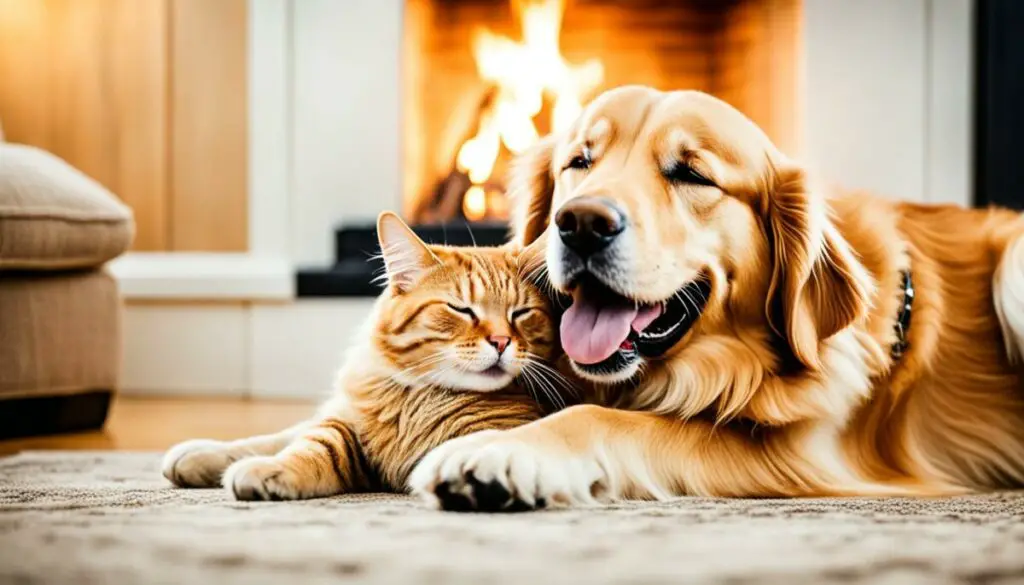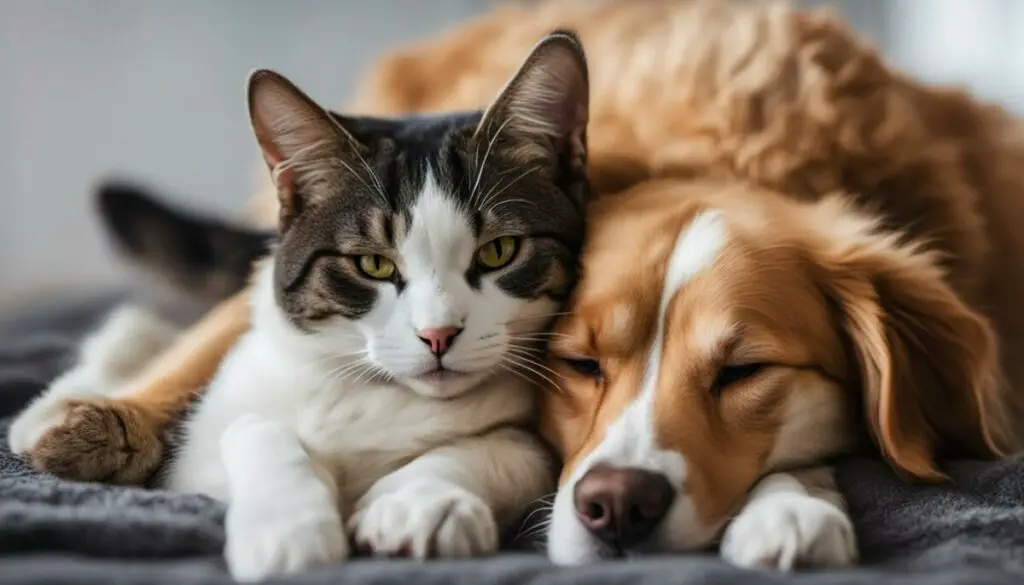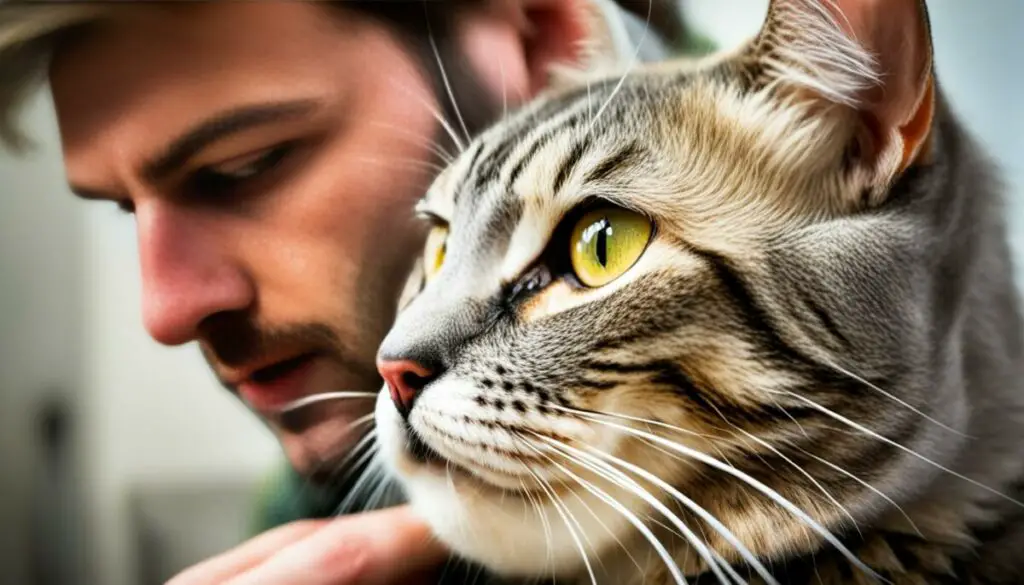Last Updated on 3 months by Francis
When a cat licks a dog, it can be a fascinating and heartwarming sight, leaving us wondering about the reasons behind this interspecies grooming behavior. It’s not uncommon to witness such interactions between cats and dogs, as they navigate their unique relationship filled with companionship and affection.
One of the reasons why a cat may lick a dog is to mimic the behavior it learned from its mother. Just like how a mother cat grooms her kittens as an act of nurturing and showing affection, cats may continue this grooming ritual with dogs. It’s a way for them to express their fondness and bond with their canine friends.
Aside from affectionate gestures, cats may also lick dogs as a means of grooming them. Cats are fastidious groomers by nature, and they extend this grooming behavior to their furry companions. By licking the dog’s fur, they help remove dirt and debris, keeping the dog’s coat clean and healthy.
Furthermore, the taste of the dog’s fur can be enjoyable for cats, or it could serve as a stress-relieving activity. Cats may find solace and comfort in licking the dog, especially during moments of anxiety or tension. In some cases, the act of licking can be a way for the cat to seek attention from the dog, initiating play or seeking reassurance.
This cross-species grooming behavior between cats and dogs can be seen as a positive aspect of their relationship. It promotes a deeper bond, an understanding of each other’s needs, and creates a harmonious environment for both pets to thrive.
Contents
Key Takeaways:
- Cat licking a dog is a sign of affection and bonding between the two species.
- Cats may mimic their mother’s grooming behavior and continue to groom dogs as a way of showing affection.
- Grooming the dog helps keep their coat clean and healthy.
- Licking can relieve stress and seek attention.
- This behavior strengthens the bond between cats and dogs, promoting companionship and a harmonious environment.
Why Does My Dog Lick My Cat?

Dogs licking cats is a behavior that may seem peculiar to us, but it can actually be quite common and even beneficial. There are several reasons why dogs engage in this behavior, and it can shed light on the complex dynamics of the dog-cat relationship.
Affection and bonding: Dogs may lick cats as a way to show affection, similar to how they lick their owners. This behavior is a sign of their social bond and can help strengthen the relationship between them.
Grooming instinct: Dogs have a natural instinct to groom other animals, especially within their pack. This instinct may lead them to groom cats as a way of bonding and showing care.
Taste: Some dogs may simply enjoy the taste of the cat’s fur. It can be a sensory experience for them, and they may find it pleasurable.
Stress relief: Licking can be a stress-relieving behavior for dogs. It releases endorphins, which create a sense of calm and relaxation. Dogs may lick cats as a way to alleviate their own stress or anxiety.
Attention-seeking: Dogs often seek attention from those around them, including cats. Licking can be a behavior dogs use to get the attention of the cat or to initiate play.
Overall, the behavior of dogs licking cats is multifaceted and can be influenced by various factors. It is important to observe the dynamics between your dog and cat to understand the motivations behind this behavior. While it is generally harmless and can indicate a positive relationship, it is essential to monitor the frequency and intensity of licking to ensure the comfort of both animals.
“Dogs licking cats is a behavior that can foster a closer relationship between them and strengthen their bond.”
To better understand the behavior of dogs licking cats, let’s take a look at a table that summarizes the reasons behind this behavior:
| Reasons Behind Dog Licking Cat |
|---|
| Affection and bonding |
| Grooming instinct |
| Taste |
| Stress relief |
| Attention-seeking |
The table provides a clear overview of the reasons why dogs may lick cats. Understanding these motivations can help pet owners navigate and interpret their pets’ behaviors, fostering a harmonious coexistence between dogs and cats.
Now that we’ve explored the reasons behind dogs licking cats, let’s move on to the next section and discover the benefits of this behavior.
The Benefits of Your Dog Licking Your Cat

When a dog licks a cat, it can offer a range of benefits for both animals. Let’s explore the advantages that your dog’s loving gestures can bring to your feline friend.
1. Promotes Cat Health
By licking your cat, your dog helps to keep your cat’s coat clean and healthy. The gentle action of licking helps remove dirt, debris, and loose hair from the cat’s fur, preventing matting and reducing the risk of skin irritations. This grooming behavior can contribute to a softer and more lustrous coat for your cat.
2. Reduces Stress in Cats
Licking has a soothing effect on cats and can help reduce their stress levels. When a dog licks a cat, it releases endorphins in the cat’s body, creating a sense of calm and relaxation. This can be especially beneficial for anxious or nervous cats, as the act of being groomed can provide them with comfort and reassurance.
3. Strengthens the Cat-Dog Bond
The act of licking creates a bond between animals, and the same applies to cats and dogs. When your dog licks your cat, it signifies a display of affection and care. This form of interaction fosters a closer relationship between your pets, helping them build trust and camaraderie.
Remember to monitor the licking behavior to ensure it remains gentle and non-disruptive for your cat. If the licking becomes excessive or bothersome, it’s advisable to redirect your dog’s attention or provide alternative outlets for their affection.
| Benefits of Your Dog Licking Your Cat | Description |
|---|---|
| Promotes Cat Health | Keeps the cat’s coat clean, free of debris, and reduces skin irritations. |
| Reduces Stress in Cats | Relieves anxiety and creates a sense of calm through the release of endorphins. |
| Strengthens the Cat-Dog Bond | Builds trust, enhances companionship, and deepens the relationship between cats and dogs. |
Overall, the gentle act of your dog licking your cat provides numerous benefits. It helps maintain your cat’s coat health, reduces stress, and strengthens the bond between your furry companions. Just make sure to supervise the interaction and ensure it remains comfortable for both pets.
Types of Feline Aggression

Feline aggression is a common issue that many cat owners face. Aggression in cats can be triggered by various factors and can have significant consequences if not properly addressed. It’s essential to understand the different types of cat aggression and recognize the signs to effectively manage and reduce aggressive behavior.
1. Play Aggression
Play aggression is often seen in young cats and kittens. During playtime, cats may exhibit stalking, pouncing, and biting behaviors. While it may seem harmless, it’s important to redirect this aggression to appropriate toys to prevent injuries and foster positive play experiences.
2. Fear Aggression
Fear aggression occurs when cats feel threatened or scared by a particular situation or stimulus. Cats may display defensive behaviors such as hissing, flattened ears, dilated pupils, and crouching low to the ground. It’s crucial to create a safe and calm environment for fearful cats to reduce their anxiety and prevent aggressive outbursts.
3. Petting-Induced Aggression
Petting-induced aggression can occur when a cat becomes overstimulated during petting. Cats may suddenly display aggressive behaviors such as biting or scratching. It’s essential to pay attention to a cat’s body language, such as tail flicking or ears flattening, to recognize when they’ve had enough and avoid triggering aggressive responses.
4. Redirected Aggression
Redirected aggression happens when a cat is unable to respond directly to a perceived threat or excitement and instead redirects its aggression towards another target, such as a person or another animal. This type of aggression can be sudden and intense. Recognizing and removing the triggering stimulus can help prevent redirected aggression.
5. Pain-Induced Aggression
Cats in pain may display aggression as a means to protect themselves from touch or certain activities that cause discomfort. Pain-induced aggression can include hissing, growling, or even biting. It’s crucial to identify and address any underlying pain or medical conditions to alleviate the aggressive behavior.
6. Status-Induced Aggression
Status-induced aggression occurs when cats are establishing dominance or asserting their territory. This can manifest through behaviors such as blocking doorways or swatting at other cats. Providing a structured environment and avoiding confrontations can help manage status-induced aggression.
7. Territorial Aggression
Cats are naturally territorial, and territorial aggression can arise when they feel their territory is threatened. This aggression is directed towards intruders or other animals encroaching on their space. Gradual reintroduction of cats, territorial marking, and positive reinforcement for non-aggressive behavior can help manage territorial aggression.
Recognizing signs of aggression, such as dilated pupils, flattened ears, and an arched back, is crucial in addressing and managing feline aggression. It’s also important to consult with a veterinarian or animal behaviorist for guidance on behavior modification techniques, environmental enrichment, and strategies to create a harmonious home environment.
Summary Table: Types of Feline Aggression
| Types of Feline Aggression | Signs and Behaviors | Management Strategies |
|---|---|---|
| Play Aggression | Stalking, pouncing, biting during play | Redirect aggression to appropriate toys, discourage rough play |
| Fear Aggression | Hissing, flattened ears, dilated pupils | Create a safe environment, desensitize to triggers, provide hiding spots |
| Petting-Induced Aggression | Biting, scratching during petting | Recognize signs of overstimulation, respect boundaries, end petting sessions |
| Redirected Aggression | Sudden, intense aggression toward a different target | Remove triggering stimulus, redirect attention to toys or calming activities |
| Pain-Induced Aggression | Hissing, growling, biting due to pain | Identify and treat underlying pain or medical conditions |
| Status-Induced Aggression | Blocking doorways, swatting at other cats | Provide a structured environment, avoid confrontations |
| Territorial Aggression | Defending territory from intruders | Gradual reintroduction of cats, territorial marking, positive reinforcement |
Managing Feline Aggression

Managing cat aggression is essential for the well-being of both cats and their owners. Early intervention is key to preventing the escalation of aggressive behaviors. Physical punishment should be avoided as it can exacerbate aggression and cause fear or anxiety in cats.
Implementing behavioral and environmental modifications is crucial in addressing cat aggression effectively. These modifications may include creating a safe and enriched environment, providing ample resources, and ensuring proper socialization. In some cases, medication prescribed by a veterinarian may be necessary to help manage aggressive behavior.
Recognizing the signs of aggression is fundamental to implementing appropriate intervention strategies. Using noise deterrents, such as clapping hands or using a spray bottle with water, can startle an aggressive cat without physical contact. This can help redirect their attention and discourage aggressive behavior.
Additionally, avoiding situations or triggers that provoke aggression is important. If multiple cats are involved, separating aggressive cats can prevent conflicts and reduce stress. Positive reinforcement training, using food treats or praise, can be employed to reward non-aggressive behaviors and encourage a calm demeanor.
If aggression persists despite these interventions, it is advisable to seek the professional guidance of a veterinary behaviorist. These experts specialize in understanding and managing complex behavioral issues in animals, including feline aggression.
Play Aggression in Cats
Play aggression is a common behavior observed in young cats and kittens. It typically occurs when cats haven’t learned appropriate play behavior during their socialization with littermates. During play aggression, cats may exhibit stalking, pouncing, and biting behaviors.
To effectively manage play aggression in cats, it is essential to identify patterns and redirect their behavior through play or by denying access to areas that encourage aggression. Implementing noise deterrents can startle the cat and redirect its attention away from aggressive behavior.
Consistent reinforcement of non-aggressive behavior using positive rewards is vital in managing play aggression. Rewarding cats for exhibiting calm and gentle play can help modify their play behavior over time.
“Redirecting the cat’s behavior through play or by denying access to areas that encourage aggression can help manage play aggression.”
| Managing Play Aggression in Cats | |
|---|---|
| Identify patterns of play aggression | |
| Redirect behavior with play or by denying access to triggering stimuli | |
| Utilize noise deterrents to startle the cat and redirect its attention | |
| Consistently reinforce non-aggressive behavior with positive rewards | |
| Supervise children and teach them to recognize signs of play aggression |
Supervision is crucial, especially when children are involved, to prevent accidents. Teaching children to recognize signs of play aggression and interacting appropriately with the cat can help maintain a safe environment for both the cat and the child.
Fear and Petting-Induced Aggression in Cats
Fear aggression in cats can be a result of encountering unfamiliar stimuli or having negative experiences associated with certain situations. Common symptoms of fear aggression include flattened ears, dilated pupils, hissing, and crouching low to the ground. On the other hand, petting-induced aggression can occur suddenly when a cat becomes overstimulated during petting sessions.
To effectively manage fear and petting-induced aggression in cats, it is crucial to either avoid or gradually desensitize them to the triggering stimuli. Consoling or showing fear in response to their aggression should be avoided, as it may reinforce their behavior. It is important to give attention to the cat only when it is relaxed and receptive. Supervision and prevention of physical contact with aggressive cats are essential, especially when children are present.
Recognizing Fear Aggression
Fear aggression can manifest in various ways, including:
- Flattened ears
- Dilated pupils
- Hissing
- Crouching low to the ground
Should you notice these signs in your cat, it is crucial to create a safe and calm environment for them and seek appropriate guidance from a professional veterinary behaviorist.
Managing Petting-Induced Aggression
When it comes to petting-induced aggression, it is essential to pay attention to your cat’s body language and recognize when they are becoming overstimulated. Signs of overstimulation may include a tensed body, twitching tail, or an increased rate of blinking.
To prevent petting-induced aggression:
- Observe your cat’s behavior and learn their tolerance level for petting. Stop petting as soon as you notice any signs of discomfort or agitation.
- Provide alternative forms of affection, such as interactive play or gentle brushing, that your cat may find more enjoyable and less overstimulating.
- Consider consulting with a veterinarian or animal behaviorist for additional guidance and support in managing petting-induced aggression in your cat.
Remember, every cat is unique, and it may take time and patience to find the right approach that helps alleviate their fear and manage their aggression effectively.
Redirected and Pain-Induced Aggression in Cats
Redirected aggression in cats can occur when they are unable to respond directly to an exciting stimulus and redirect their aggression towards another target, such as a person or another animal. This behavior can be triggered by various factors, including territorial disputes or fear. It is essential to understand and address redirected aggression to maintain a harmonious environment for both cats and their human companions.
Pain-induced aggression in cats can arise when they are experiencing physical discomfort or pain. Cats may attempt to avoid touch or certain activities that exacerbate their pain, leading to aggressive behavior. Identifying and managing pain-induced aggression is crucial to ensure the well-being and safety of both cats and their caregivers.
To effectively manage redirected and pain-induced aggression in cats, several strategies can be employed:
- Prevention: Identify and remove stimuli that trigger redirected aggression. This may involve creating a calm and secure environment, reducing exposure to potential triggers, or providing ample space and resources for each cat to establish their territory.
- Controlling pain: If pain is the underlying cause of aggression, it is vital to seek veterinary care to diagnose and address the source of pain. Treatment options may include medication, physical therapy, or lifestyle modifications.
- Avoiding touch: In cases of pain-induced aggression, it is crucial to avoid touching the areas that cause discomfort or pain for the cat. Respect their boundaries and provide alternative ways to interact and bond.
- Positive reinforcement: Consistently reward non-aggressive behavior with praise, treats, or playtime to reinforce positive interactions. This can help cats associate good behavior with positive outcomes and reduce the likelihood of aggression.
Case Study: Redirected Aggression
“My two cats, Bella and Max, had always been the best of friends. However, one day, while Bella was sitting by the window and witnessed an intense altercation between two neighborhood cats, she became highly agitated. When I tried to approach her, she redirected her aggression towards me, scratching and hissing. Understanding that this was a case of redirected aggression, I immediately created a calm environment for Bella. I closed the curtains to prevent her from watching outside and provided her with a safe space, equipped with toys and a cozy bed. Over time, with patience and positive reinforcement, Bella’s redirected aggression subsided, and she returned to her usual friendly and affectionate self.”
Managing redirected and pain-induced aggression requires a comprehensive approach that prioritizes the physical and emotional well-being of cats. By implementing preventive measures, effectively addressing pain, and utilizing positive reinforcement techniques, cat caregivers can create a peaceful and harmonious environment that promotes healthy interactions and relationships.
Status and Territorial Aggression in Cats
Cats have a natural instinct to establish dominance and protect their territory, which can lead to status-induced and territorial aggression. Status-induced aggression is displayed through behaviors like blocking doors or swatting. To manage status-induced aggression, it is important to ignore the cat’s aggressive behavior and provide attention only when it is relaxed, rewarding calm and non-aggressive behavior.
“Ignoring the cat and providing attention only when it is relaxed can help manage status-induced aggression.”
Territorial aggression, on the other hand, occurs when cats defend their territory from perceived intruders. This can lead to aggressive behaviors such as hissing, growling, or physically attacking the intruder. To manage territorial aggression, prevention of confrontations is crucial. Gradual reintroduction of cats can help them become accustomed to each other’s presence, reducing the likelihood of territorial disputes.
Positive reinforcement for non-aggressive behavior plays a significant role in managing both status-induced and territorial aggression in cats. Rewarding cats when they exhibit calm and non-aggressive behavior can help reinforce positive behavior patterns and reduce aggression over time.
Managing Status-Induced Aggression in Cats:
- Ignore the cat’s aggressive behavior
- Provide attention and rewards only when the cat is relaxed
- Reinforce calm and non-aggressive behavior through positive reinforcement
Managing Territorial Aggression in Cats:
- Prevent confrontations by keeping cats separated when necessary
- Gradually reintroduce cats to each other’s presence
- Provide positive reinforcement for non-aggressive behavior
Understanding and managing status-induced and territorial aggression in cats is essential for maintaining a harmonious environment and promoting the well-being of all feline residents.
| Causes of Status-Induced Aggression | Managing Status-Induced Aggression |
|---|---|
| Establishing dominance | Ignoring the cat’s aggressive behavior |
| Protecting resources | Providing attention only when the cat is relaxed |
| Asserting territorial boundaries | Reinforcing calm and non-aggressive behavior |
| Causes of Territorial Aggression | Managing Territorial Aggression |
|---|---|
| Perceived intrusion by another cat | Preventing confrontations |
| Protecting territory from animals or humans | Gradually reintroducing cats |
| Defending resources within their territory | Providing positive reinforcement for non-aggressive behavior |
Why Does My Cat Lick Me: Affectionate Behavior
Cats have a unique way of showing affection towards humans, and one common behavior is licking. When a cat licks you, it’s not just a random action; it serves as a form of social bonding and a display of love and care. This behavior is deeply rooted in their early interactions with their mother, who would lick them as a means of grooming and showing affection. When a cat licks you, it’s their way of mimicking this behavior and establishing a close bond with you.
Not only does licking serve as a sign of affection, but cats may also lick humans to mark them as part of their territory. By leaving their scent on you, they are essentially claiming you as their own and showing other cats that you are off-limits.
However, it’s important to note that excessive licking can sometimes indicate stress or anxiety in cats. If your cat is constantly licking you or themselves to the point of irritation, it’s crucial to address any underlying issues that may be causing this behavior. Providing a calm and enriched environment, ensuring their physical and emotional needs are met, and seeking guidance from a veterinarian or animal behaviorist can help alleviate any stress or anxiety your cat may be experiencing.
Remember, understanding the reasons behind your cat’s licking behavior can help strengthen the bond between you and ensure a happy and healthy relationship. If you’re unsure about your cat’s behavior or have any concerns, consulting with a professional can provide you with the guidance and support you need.
Benefits of Cats Licking Humans:
| Benefits | Description |
|---|---|
| 1. Strengthening the Bond | Licking is a way for cats to express their affection and establish a deeper connection with their owners. |
| 2. Grooming and Hygiene | Through licking, cats help to keep their owners clean by removing dirt and dead skin cells. |
| 3. Emotional Comfort | Licking releases endorphins in cats, providing them with a sense of calm and contentment while also offering comfort to their owners. |
| 4. Territory Marking | By licking humans, cats leave their scent as a way to mark you as part of their territory. |
| 5. Communication | Licking can be a cat’s way of expressing their needs and desires, such as hunger, attention, or playtime. |
Conclusion
Cat licking behavior towards dogs can be influenced by a variety of factors, including affection, grooming instincts, taste, stress relief, and seeking attention. This behavior is generally harmless and can have positive effects on both the cat and the dog, fostering bonding, improving the cat’s coat health, reducing stress, and strengthening their relationship.
However, it is important to monitor the behavior and intervene if it becomes obsessive or causes discomfort for either pet. Understanding feline aggression and employing appropriate management techniques are essential for maintaining a harmonious environment when cats interact with either other cats or other animals.
By promoting a safe and positive cat and dog interaction, pet owners can create a nurturing environment where their furry companions can coexist peacefully. Whether it’s managing their grooming habits, introducing them slowly, or providing them with separate spaces, taking proactive steps to nurture the cat and dog relationship is key to ensuring long-term happiness for both pets and their human families.
FAQ
Why does a cat lick a dog?
Cats may lick dogs as a sign of affection, to mimic grooming behavior, enjoy the taste of the fur, relieve stress, or seek attention.
Why does a dog lick a cat?
Dogs may lick cats as a way to show affection, mimic pack behavior, enjoy the taste of the fur, relieve stress, or establish a closer relationship.
What are the benefits of a dog licking a cat?
Licking can remove dirt from the cat’s fur, promote a healthier coat, reduce stress, and strengthen the bond between cats and dogs.
What are the types of feline aggression?
Types of feline aggression include play aggression, fear aggression, petting-induced aggression, redirected aggression, pain-induced aggression, status-induced aggression, and territorial aggression.
How can feline aggression be managed?
Feline aggression can be managed through behavioral and environmental modifications, possible medication, noise deterrents, avoidance of trigger situations, separation of aggressive cats, and positive reinforcement of non-aggressive behavior.
How to manage play aggression in cats?
Play aggression in cats can be managed by redirecting behavior, denying access to areas that encourage aggression, using noise deterrents, and reinforcing non-aggressive behavior.
How to manage fear and petting-induced aggression in cats?
Fear and petting-induced aggression in cats should be managed by avoiding or gradually desensitizing cats to triggering stimuli, giving attention only when the cat is relaxed, supervising physical contact, and preventing accidents with children.
How to manage redirected and pain-induced aggression in cats?
Redirected and pain-induced aggression in cats can be managed by controlling and removing triggering stimuli, treating pain, avoiding touch in painful areas, and positively reinforcing non-aggressive behavior.
How to manage status and territorial aggression in cats?
Status and territorial aggression in cats can be managed by ignoring the cat’s behavior, providing attention when the cat is relaxed, preventing confrontations, gradually reintroducing cats, and reinforcing non-aggressive behavior.
Why does a cat lick a human?
Cats may lick humans as a form of social bonding, to show affection, or to mark them as part of their territory.
What is the significance of cat licking a dog?
Cat licking a dog can promote bonding, improve the cat’s coat health, reduce stress, and strengthen the relationship between cats and dogs.
How can cat and dog interaction be managed?
Cat and dog interaction can be managed by monitoring the behavior, intervening if it becomes obsessive or uncomfortable, and employing appropriate training and introductions to ensure a harmonious environment.
Source Links
- https://www.dakpets.com/blogs/news/why-do-dogs-lick-cats-the-reason-behind-this-odd-behavior
- https://www.vet.cornell.edu/departments-centers-and-institutes/cornell-feline-health-center/health-information/feline-health-topics/feline-behavior-problems-aggression
- https://www.purina.co.uk/articles/cats/behaviour/understanding-cats/why-does-my-cat-lick-me








